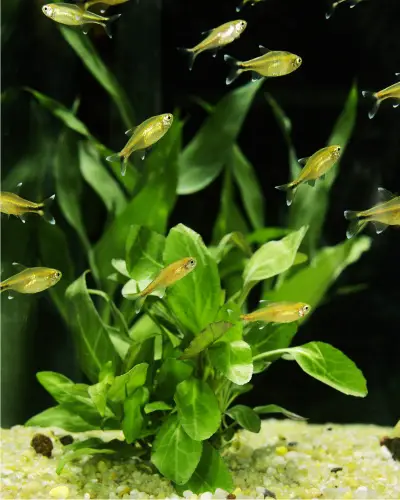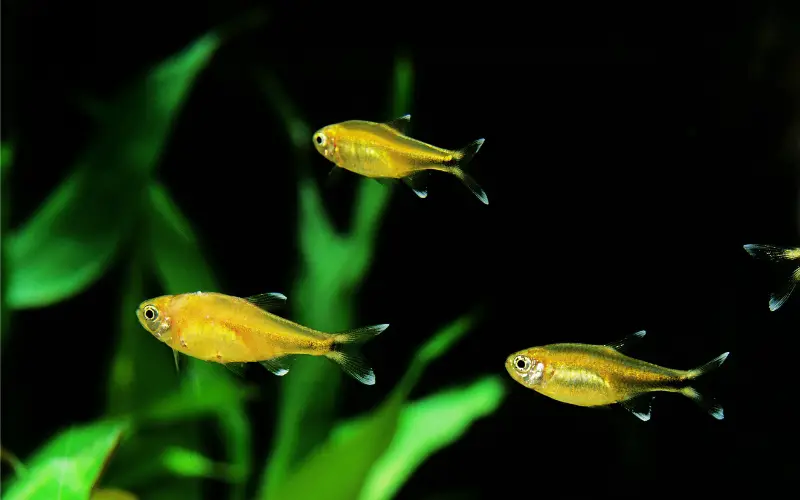Silver Tip Tetra breeding isn’t just about watching nature take its course; it’s a fascinating journey into the world of aquatic reproduction. It can be rewarding for both seasoned aquarists and curious beginners.
The shimmering silver flash of a Silver Tip Tetra darting through your aquarium is a joy to behold.
But have you ever wondered what it takes to bring these vibrant fish from tiny fry to stunning adults?
This silvertip tetra breeding and care guide will take you from creating the perfect breeding environment to nurturing that delicate fry.

You’ll learn about the subtle cues that indicate breeding readiness, the techniques for triggering spawning, and the essential care needed for raising healthy, vibrant Silver Tip Tetras.
Get ready to embark on a captivating adventure in fish breeding, where you’ll witness the wonder of life unfolding right before you.
Table of Contents
ToggleSilver Tip Tetra Breeding Behavior and Natural Habitat
When breeding Silver Tip Tetras, is essential for setting up a separate breeding tank to prevent the adult fish from predating on the eggs and fry. These tropical fish are schooling fish that can be hard to breed in a community tank.
To encourage breeding behavior, the fish should be conditioned with high-quality frozen and live foods like daphnia, brine shrimp, and bloodworm. The breeding tank should be set up with fine-leaved plants like java moss or spawning mops to provide hiding spots for the eggs.

The tank’s water quality must be kept pristine, with frequent water changes to mimic their acidic natural habitat. Silver Tip Tetras are omnivores and will nip at the fins of long-finned fish, so it’s best to keep them with slow-moving species like Corydoras or Hasemania nana.
During breeding, the male tetra chases the female around the tank, leading her to a spawning site where she releases her eggs. The eggs stick to the plants or spawning mops and hatch within 24-36 hours. Once hatched, the baby fish feed on infusoria until they become free-swimming.
To ensure the health of the fry, it is important to keep the water temperature stable and provide a varied diet of pellets, frozen foods, and live foods.
Once the young tetras grow large enough to avoid being eaten by larger tankmates like barbs or betta fish, they can be introduced to the main tank with other community fish.
Optimal Water Parameters for Silvertip Tetra Breeding
Like any other living creature, white Tip Tetras thrive in specific conditions, and their breeding success depends heavily on the water they inhabit. Here’s a breakdown of the optimal water parameters for a successful breeding experience:
Temperature:
- Ideal Range: 78-82°F (25-28°C)
- Importance: A slightly warmer temperature than their usual tank environment encourages spawning behavior and faster fry development.
pH:
- Ideal Range: 6.5-7.0
- Importance: A slightly acidic pH mimics the natural environment of these fish and helps with egg development.
Hardness (GH):
- Ideal Range: 5-10 dGH
- Importance: Soft to moderately hard water helps prevent stress and encourages spawning.
Other Important Factors:
- Water Changes: Regular water changes are essential for maintaining healthy water quality, removing waste products, and ensuring proper oxygen levels.
- Filtration: A powerful filtration system is crucial to maintain water clarity and remove harmful bacteria.
- Nitrate Levels: Keep nitrate levels as low as possible, ideally below 20 ppm.
Tips for Achieving Optimal Parameters:
- Conditioning Water: Use a water conditioner to remove harmful chlorine and chloramine before adding it to the breeding tank.
- Temperature Control: Utilize a heater to maintain the desired temperature range.
- pH Adjustments: If necessary, use a pH buffer to achieve the optimal pH level.
- Regular Monitoring: Monitor water parameters regularly using a reliable test kit.
Note: It’s crucial to ensure that the breeding tank’s water parameters are stable and consistent. Sudden changes in water quality can stress the fish and negatively impact their breeding success.
Understanding and diligently maintaining these optimal water parameters set the stage for a successful Silver Tip Tetra breeding journey, giving your fish the best chance to thrive and produce healthy offspring.
How to Set Up an Aquarium for Silvertip Tetras
When setting up an aquarium for Silvertip Tetras, it is essential to consider their specific needs. These tetra species are community fish that thrive in groups of at least six individuals.
A tank size of at least 20 gallons is recommended to provide enough space for them to swim and explore. The water conditions should mimic their natural habitat in south america rivers and streams.
Fine-leaved plants such as Java moss and water sprite can be added to the tank to create hiding spots and mimic their natural environment.
Diet: Silvertip Tetras should be fed a varied diet of frozen and live foods, such as brine shrimp nauplii, to ensure their health and well-being. A balanced diet is important to keep them healthy and thriving in the aquarium.
Breeding Silver-tip Tetras: A separate breeding tank is recommended to prevent the parents from reaching the eggs. A tank higher than the main tank, with a mesh bottom to allow eggs to fall through, can help to protect the eggs until they hatch. The best-coloured male and female should be selected for breeding to produce healthy offspring.
Compatibility: Silvertip Tetras can be kept with other peaceful fish species such as Zebra Danios, Mollies, Rasboras, and cichlids. Keeping the aquarium lights turned off at night is essential to mimic their natural habitat and provide a healthy environment for these beautiful fish.
Best Compatible Silver Tip Tetra Tank Mates When Breeding Silvertip Tetras
When breeding silvertip tetras, it is important to choose compatible tank mates. These fish are conditioned to thrive in a community aquarium, so keeping them with similar-sized fish like platies would be ideal.
The Silvertip Tetras are known for their stunning silver bodies with a black stripe running from their dorsal and anal fins. To ensure successful breeding, keeping them in groups in at least a 10-gallon tank with driftwood and rocks for hiding places is recommended.
Providing them with catappa leaves and slightly acidic water will mimic their natural habitat in the basin in Brazil.
For the breeding process, feeding the adults various live and frozen foods such as microworms and freeze-dried options is essential. A well-balanced diet will help them stay healthy and vibrant, increasing the chances of successful breeding.
When selecting breeding pairs, choose the best-colored male with vibrant colors and a healthy appearance. Breeding occurs when the male fertilizes the eggs as they fall through the mesh of the breeding tank. The parents should be removed once breeding is complete to prevent them from eating the fry.
Commonly Asked Questions about Silver Tip Tetra Breeding (FAQs)
Are silvertip tetras easy to breed?
Silvertip tetras are moderately easy to breed. They spawn in tanks with soft water, low light, and plenty of hiding spots for eggs. The biggest challenge is protecting the eggs from the adult fish, who may eat them.
What is the easiest tetra to breed?
Several tetras, including Ember Tetras, Glowlight Tetras, and Emperor Tetras, are considered easy to breed. These fish spawn readily in small tanks with proper conditioning and hiding spots for fry.
How many silver tip tetras should be kept together?
Keep a minimum of 6 Silver Tip Tetras together for a healthy and happy school. They are schooling fish that thrive in groups, and a larger school will be more active and less prone to stress.
How fast do tetras breed?
Tetras, including Silver Tip Tetras, can quickly breed under optimal conditions. They can produce multiple batches of eggs within a few weeks, with fry hatching in about 3-5 days.
How big do silver-tip tetras get?
Silver Tip Tetras typically reach a maximum size of about 2 inches in length. They are considered small to medium-sized tetra species, making them suitable for various aquarium sizes.
Conclusion
As you’ve read this guide, you’ve learned that Silvertip Tetra breeding is not just a process but a fascinating exploration of nature’s intricate dance. By understanding their needs, creating the right environment, and being patient, you’ll witness the magic of life unfold right before your eyes.
The joy of watching tiny fry darting amongst their parents, growing strong and healthy, is gratifying. Remember, every successful breeding experience is a testament to your dedication, knowledge, and love for these captivating fish. So, take the plunge, embrace the challenge, and experience the satisfaction of nurturing a new life. The world of Silver Tip Tetra breeding is waiting for you to explore!
Recommended posts
- Silver Tip Tetra Size 101: Tips for Monitoring Their Growth!
- How to Properly Care for Silver Tip Tetra fish in Your Fish Tank!
- Top 5 Compatible Pristella Tetra Tank Mates (Ultimate Guide)
- Silver Tip Tetra Lifespan in Aquarium (Ultimate Care Guide)
- Silvertip Tetra Chasing Each Other: Is it Mating or Fight?
- Choosing Best Silvertip Tetra Tank Mates: (Dos and Don’ts)
- The Ideal Silver Tip Tetra Temperature: Comprehensive Guide
- Tips to Create a Balanced Silvertip Tetra Male vs Female Ratio
- Keeping Congo Tetra Fish 101: (A Comprehensive Care Guide)




